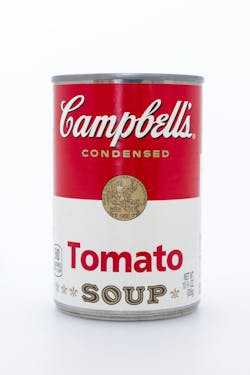Ohio Campbell's Soup facility sued for alleged Lake Erie pollution
Take a look in your pantry. Chances are you have a red and white can of Campbell’s sitting in the back somewhere. It may be forgotten, covered in dust, from last year’s holidays. Or it may be prominently displayed up front, ready to provide some relief from your cold. Campbell’s is almost synonymous with comfort.
Unfortunately, this beacon of warm meals is a source of alleged pollution in Lake Erie.
Two lawsuits filed against Campbell’s
Two non-profit groups, Environment America and Lake Erie Waterkeeper, announced on March 18, 2024, that they have filed a lawsuit in the U.S. District Court for the Northern District of Ohio against Campbell Soup Supply Company, a subsidiary of Campbell Soup Inc.
The lawsuit against Campbell’s is for allegedly violating the Clean Water Act by discharging pollutants into Maumee River from its facility, which sits about 43 miles upstream of Lake Erie.
The U.S. Department of Justice (DOJ) also filed a lawsuit, on behalf of U.S. EPA. The lawsuit lists the same violations and seeks the same relief as the other two lawsuits. It is expected that the two lawsuits will be consolidated into one single case.
Four qualities of Campbell’s alleged improper discharge in Maumee River
The Environmental Law & Policy Center (ELPC) compiled water pollution data from the Campbell’s Soup Company’s Napoleon, Ohio facility from January 2017 through March 2021 revealing it exceeded pollution limits on almost 200 occasions.
Pollutants found in the discharges include ammonia, phosphorus, total suspended solids (TSS) and carbonaceous biochemical oxygen demand (CBOD).
Every summer Lake Erie is plagued by harmful algae blooms (HABs). These HABs are greatly exaggerated when phosphorus and agricultural runoff pollution are mixed in. Ammonia has the most harmful effects in warm water increasing the impact of pollutants in the summers.
Around 200 violations between 2017 and 2021
According to a 2021 study conducted by ELPC, and data reviewed from the Campbell’s facilities discharge monitoring reports (DMRs), there were 146 daily exceedances of daily pollution limits for the four pollutants between January 2017 through March 2021.
During the same period there were 53 exceedances of monthly pollution limits.
Under the authority of the Clean Water Act, U.S. EPA can penalize a company per day and per month (considered a 30-day period).
John Rumpler, clean water program director and senior attorney for Environment Ohio, stated that his firm can only reference the past five years of data when it comes to addressing violations. Rumpler said that Campbell’s violations could be in the thousands when looking at a larger time frame like the past 10 years.
ELPC also approximated the total amount of phosphorous and CBOD pollution discharged into the river from facilities with National Pollution Discharge Elimination System (NPDES) permits and found the approximate proportion attributed to the Campbell’s facility.
ELPC found that 15% of total phosphorous discharges were coming from the Campbell’s facility. Of the approximately 242 tons of phosphorous discharged into the Lower Maumee River watershed, Campbell’s was responsible for 37 tons of that.
ELPC also found that 36% of total CBOD discharges were coming from the facility. Of the approximately 2,863 tons discharged into the watershed, the facility was responsible for 1,017 tons.
The facility has many points of discharge on the river, but the majority are from Outfall 001. This is the outfall upon which the above data is based.
Rumpler said that this data, which Environment Ohio began review about a year ago, is what prompted he and his team to begin digging deeper into Campbell’s.
“We want to hold them accountable,” said Rumpler, stating that it is in the best interest of everyone for Campbell’s to clean up its act.
“These are common pollutants. They’re not magical chemicals that engineers don’t have experience with,” Rumpler said. Campbell’s would have to implement new hardware to clean out its pollutants to comply with the Clean Water Act. Rumpler stated that this hardware, such as a modernized wastewater treatment systems or equipment, is something that engineers have already worked on and is available to the market.
Rumpler shared a sign of optimism saying that the conversation with Campbell’s has been hopeful.
Campbell’s comments
When asked to comment on the suit, a Campbell’s spokesperson reached out via email stating that it has “. . . taken a number of steps to improve our existing wastewater management operations and will continue to take immediate action to address this issue. We have retained independent experts to help implement short-term improvements and have capital investments planned to resolve this issue permanently. We take this matter seriously and will continue to work with regulators and other stakeholders to improve our operations and comply with all environmental regulations.”
The spokesperson also said that Campbell’s has a permit, like other companies and organizations, that allows discharged wastewater from the Napoleon plant into the river. The company files required monthly reports with regulators.
Since receiving the intent to sue in July, 2023, Campbell’s has been in close contact with the DOJ and EPA to “describe the work we had already done and share our comprehensive plans to comply with our permits. We are committed to cooperating with regulators and the NELC to resolve this issue.”
The National Environmental Law Center (NELC) is the non-profit group representing citizen groups, such as Environment America and the Lake Erie Waterkeeper in this case.
Ohio’s blazing history of pollution
For northeastern Ohioans, it has become common folklore that the Cuyahoga river was so heavily polluted by industry that it caught fire and burned wildly out of control.
Except it is not folklore. Although the 1969 river fire became greatly exaggerated over the years, it still cost $50,000 in damages to railroad bridges crossing the river. Oil slicks and debris could regularly be seen floating down the river, which eventually met Lake Erie.
This was not the only time the river caught fire either. In 1868, 1883, 1887, 1912, 1922, 1936, 1941, 1948 and 1952 the river went up in flames, as well. The 1952 fire caused more than $1.5 million in damages according to Not Enough to Drink: Pollution, Drought, and Tainted Water Supplies by Laura La Bella.
It is believed that the attention brought from the 1969 fire was one inspiration that led to the establishment of U.S. EPA, and eventually the Clean Water Act as we know it today.
Fast forward to the present, and back to northwest Ohio, and there are still concerns over companies allegedly polluting a river, something Ohioans still take seriously.
The want for clean Ohio rivers is something that still holds true today
A 2021 poll conducted by J. Ann Selzer of 506 voters in northwest Ohio stated that 93% of voters rank access to safe clean drinking water as the number one issue for people. It ranked above health care, jobs and wages, and also included cleaning up Lake Erie.
The poll also stated that 81% of voters favor instituting enforceable regulations to reduce manure and fertilizer runoff from Concentrated Animal Feeding Operations (CAFOs).
The poll also stated that “78% of voters favor requiring permits for all CAFOs.”
About the Author
Alex Cossin
Associate Editor
Alex Cossin is the associate editor for Waterworld Magazine, Wastewater Digest and Stormwater Solutions, which compose the Endeavor Business Media Water Group. Cossin graduated from Kent State University in 2018 with a Bachelor of Science in Journalism. Cossin can be reached at [email protected].


